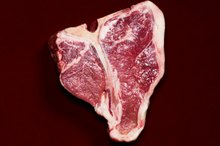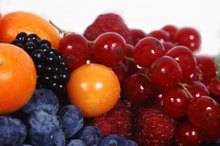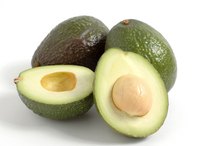What does fact checked mean?
At Healthfully, we strive to deliver objective content that is accurate and up-to-date. Our team periodically reviews articles in order to ensure content quality. The sources cited below consist of evidence from peer-reviewed journals, prominent medical organizations, academic associations, and government data.
The information contained on this site is for informational purposes only, and should not be used as a substitute for the advice of a professional health care provider. Please check with the appropriate physician regarding health questions and concerns. Although we strive to deliver accurate and up-to-date information, no guarantee to that effect is made.
Types of Carbohydrates, Acid & Alkaline
To stay healthy, you must maintain the right balance of acidic and alkaline carbohydrates in your diet. If your diet becomes too heavy on alkaline foods, you may develop alkalosis, leading to nausea and vomiting and muscle spasms that can cause stupor or coma, according to the U.S. National Institutes of Health 1. More common in the U.S. is a diet with too many acidic carbohydrates. This causes acidosis, leading to breathing problems and confusion. It is sometimes fatal.
pH-balanced Diet
Your diet is made up mainly of carbohydrates, plus fats and protein. These foods are labeled either acidic or alkaline depending on their pH value. This is an abbreviation for power of hydrogen and tells you how much hydrogen is in the food. Neutral pH is 7, above 7 is alkaline and below 7 is acidic.
Blood is already a little alkaline, so you should aim for a pH of around 7.5. Drug stores sell pH strips, which test your body’s pH if you dip them in your saliva. To achieve a balanced diet, 20 percent of your food should be acid and 80 percent should be alkaline.
- Your diet is made up mainly of carbohydrates, plus fats and protein.
- To achieve a balanced diet, 20 percent of your food should be acid and 80 percent should be alkaline.
History
PH & Weight Loss
Learn More
The human diet has evolved massively with the advent of mass production and transportation of foods. Our hunter gatherer ancestors lived on the land, eating fresh meat and grains, and generally maintained a correct pH balance. The Industrial Revolution and improvements in agriculture made grains easier to distribute. Salt mining has led to distribution of processed meat. Dairy and sugary carbohydrates like donuts are also more widely available. All these foods discharge acid into your bloodstream.
- The human diet has evolved massively with the advent of mass production and transportation of foods.
- Our hunter gatherer ancestors lived on the land, eating fresh meat and grains, and generally maintained a correct pH balance.
Foods
Foods are judged acidic or alkaline through a ratio of potential acidity or alkalinity per ounce of food. Olive oil and sunflower oil are neutral. Meat, fish, shellfish, dairy and salt are acidic. Sugary carbohydrates like cakes and donuts are acidic and should be avoided.
The best carbohydrates for alkalinity are fruit and vegetables. It may seem confusing, but even fruits like lemons that seem acidic release alkaline once digested. Figs, soybeans, lima beans, spinach and apricots offer the highest alkalinity ratios. Figs score 30 for potential alkalinity. To achieve a better pH balance in your diet, eat more fruit and vegetables and less processed meat and dessert snacks.
- Foods are judged acidic or alkaline through a ratio of potential acidity or alkalinity per ounce of food.
- Sugary carbohydrates like cakes and donuts are acidic and should be avoided.
Benefits
How to Change Your Body pH Level
Learn More
Your strength and stamina will be boosted if you maintain the suggested diet that balances your pH levels through eating four parts alkaline, one part acid. You may also lose weight. Colds, fever, influenza, headache, congestion and fatigue may be less likely to bother you if you follow a pH-balanced diet. If your diet is too acidic, stomach ulcers, kidney stones, cardiovascular disease, bladder trouble, dry skin, headaches, depression, irritation, stress and premature aging may arise.
- Your strength and stamina will be boosted if you maintain the suggested diet that balances your pH levels through eating four parts alkaline, one part acid.
- Colds, fever, influenza, headache, congestion and fatigue may be less likely to bother you if you follow a pH-balanced diet.
Related Articles
References
- MedlinePlus: Alkalosis
- Liferesearchuniversal.com: Acid/Alkaline Food Chart
- Trans4mind.com: Balancing Acid/Alkaline Foods
- The Telegraph, "Cleanse your body with the alkaline diet." Dec. 29, 2014
- Han H, Segal AM, Seifter JL, Dwyer JT. Nutritional Management of Kidney Stones (Nephrolithiasis). Clin Nutr Res. 2015;4(3):137-52. DOI: 10.7762/cnr.2015.4.3.137
- Schwalfenberg GK. The alkaline diet: is there evidence that an alkaline pH diet benefits health?. J Environ Public Health. 2012;2012:727630. DOI:10.1155/2012/727630
- Remer, T et al. Potential Renal Acid Load of Foods and its Influence on Urine pH, Journal of the American Dietetic Association, Volume 95, Issue 7, 791 - 797 DOI:10.1016/S0002-8223(95)00219-7
- Dawson-Hughes B, Harris SS, Ceglia L. Alkaline diets favor lean tissue mass in older adults. Am J Clin Nutr. 2008;87(3):662-5. doi: 10.1093/ajcn/87.3.662
- Fagherazzi G, Vilier A, Bonnet F, et al. Dietary acid load and risk of type 2 diabetes: the E3N-EPIC cohort study. Diabetologia. 2014;57(2):313-20. doi:10.1007/s00125-013-3100-0
- Xu H, Åkesson A, Orsini N, Håkansson N, Wolk A, Carrero JJ. Modest U-Shaped Association between Dietary Acid Load and Risk of All-Cause and Cardiovascular Mortality in Adults. J Nutr. 2016;146(8):1580-5. doi:10.3945/jn.116.231019
- Han E, Kim G, Hong N, et al. Association between dietary acid load and the risk of cardiovascular disease: nationwide surveys (KNHANES 2008-2011). Cardiovasc Diabetol. 2016;15(1):122. doi:10.1186/s12933-016-0436-z
- Jia T, Byberg L, Lindholm B, et al. Dietary acid load, kidney function, osteoporosis, and risk of fractures in elderly men and women. Osteoporos Int. 2015;26(2):563-70. doi:10.1007/s00198-014-2888-x
- Rebholz CM, Coresh J, Grams ME, et al. Dietary Acid Load and Incident Chronic Kidney Disease: Results from the ARIC Study. Am J Nephrol. 2015;42(6):427-35. doi:10.1159/000443746
Writer Bio
Based in London, Martin Green has written news, health and sport articles since 2008. His articles have appeared in “Essex Chronicle," “The Journal” and various regional British newspapers. Green holds a Master of Arts in creative writing from Newcastle University and a Bachelor of Arts in English literature.









